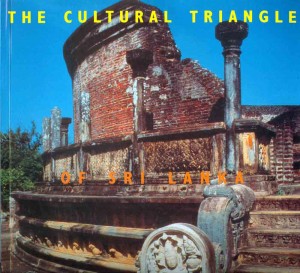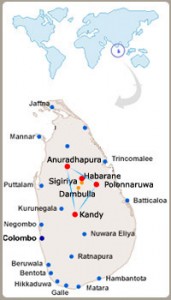 Sri Lanka’s Cultural Triangle embraces an area encompassing the ancient sites of Anuradhapura, Dambulla, Polonnaruwa, and Segiriya, and the city of Kandy. This area is perhaps the area most visited on the island, and is well worth the trip. Each of the ancient sites have book kiosks in the museums, and there are a number of hawkers selling books as well. Many of the books have pretty pictures but are not all that informative. Others are essentially archaeological monographs dedicated to one area. For our money, the most comprehensive of all of them is The Cultural Triangle of Sri Lanka by UNESCO (2006, ISBN 9789231028748), comprising a series of essays and pictures on the Abhayagiri Vihara and Jetavana sites in Anuradhapura, and the other sites at Polonnaruwa, Sigiriya, Dambulla, and Kandy.
Sri Lanka’s Cultural Triangle embraces an area encompassing the ancient sites of Anuradhapura, Dambulla, Polonnaruwa, and Segiriya, and the city of Kandy. This area is perhaps the area most visited on the island, and is well worth the trip. Each of the ancient sites have book kiosks in the museums, and there are a number of hawkers selling books as well. Many of the books have pretty pictures but are not all that informative. Others are essentially archaeological monographs dedicated to one area. For our money, the most comprehensive of all of them is The Cultural Triangle of Sri Lanka by UNESCO (2006, ISBN 9789231028748), comprising a series of essays and pictures on the Abhayagiri Vihara and Jetavana sites in Anuradhapura, and the other sites at Polonnaruwa, Sigiriya, Dambulla, and Kandy.
The book is large format (11.5” tall x 9.5” wide) and has 200 pages. It is available in most onsite museum bookstores, but buyer beware: depending on weather and storage conditions in the shops, you may find pages stuck together, the book warped, some mildew, etc. The best conditioned copy we found was in the museum shop at Sigiriya. But we’re sure glad we found it, it’s a beauty.
 The book features the work of nine essayists, and the writing’s surprisingly good, especially the work of P.L. Prematilleke and L.K. Karunaratne, who turn a few good phrases in their descriptions of Polonnaruwa. What surprised us here at WoWasis is how much we missed when we toured the sites ourselves: a lot at Anuradhapura (we should have taken two days), and the beautiful lotus pond at Polonnaruwa. There’s a lot to be said for taking the book back to your hotel room at night, and reading about the site you’re at before you leave it. The minutiae is fascinating, too. Polonnaruwa and Anuradhapura were both covered by jungle for 600 years; it took 93 million (!) bricks to build the Jetavana; locals were asked to donate 1 rupee a day to help restore Jetavana; small souvenir sculptures of the striking frescoed apsaras were made in the era when those beautiful women were originally painted. And there’s a terrifically informative essay at the end, describing UNESCO’s involvement with these Sri Lankan sites as well as their initial push to save Egypt’s Abu Simbel from inundation.
The book features the work of nine essayists, and the writing’s surprisingly good, especially the work of P.L. Prematilleke and L.K. Karunaratne, who turn a few good phrases in their descriptions of Polonnaruwa. What surprised us here at WoWasis is how much we missed when we toured the sites ourselves: a lot at Anuradhapura (we should have taken two days), and the beautiful lotus pond at Polonnaruwa. There’s a lot to be said for taking the book back to your hotel room at night, and reading about the site you’re at before you leave it. The minutiae is fascinating, too. Polonnaruwa and Anuradhapura were both covered by jungle for 600 years; it took 93 million (!) bricks to build the Jetavana; locals were asked to donate 1 rupee a day to help restore Jetavana; small souvenir sculptures of the striking frescoed apsaras were made in the era when those beautiful women were originally painted. And there’s a terrifically informative essay at the end, describing UNESCO’s involvement with these Sri Lankan sites as well as their initial push to save Egypt’s Abu Simbel from inundation.
All in all, this is the book you’ll want to buy when you’re in the area, and makes for compelling reading before and after you visit the sites.
Leave a Reply